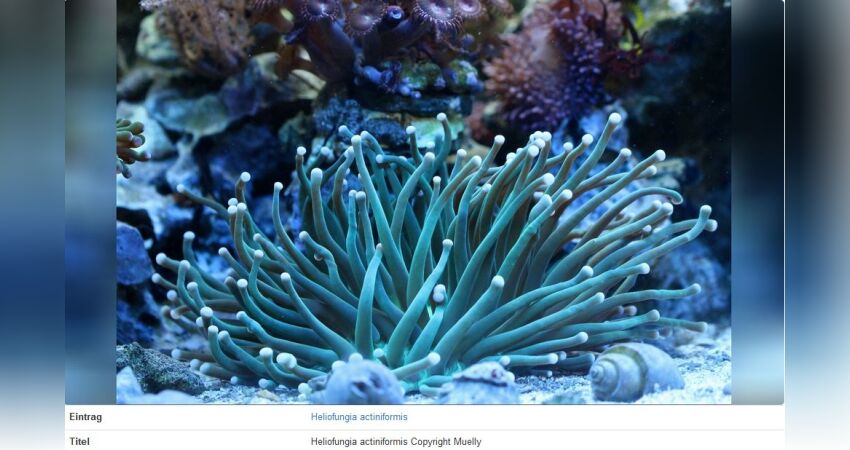FUNGIA Mushroom Corals
Single polyps or colonies?
The anatomy of mushroom corals is unusual. Like most corals, the living tissue consists only of a very thin matrix. In comparison, the skeleton is very heavy and yet they can still actively move around by absorbing water, which is a truly amazing ability. Many species are single polyps, some have multiple mouths and are considered colonies, others consist of typical colonies with multiple polyps. The encrusting attached species are similar in appearance to common coral colonies. Among the free-living ones, there are genera such as Herpolitha or Polyphyllia, with several loosely arranged mouths in the mid-furrow. Halomitra developed several small polyps evenly distributed over the skeleton. Gittenberger, Reijnen, Hoeksema describe that the formation of colonies occurred several times independently in different. Genera.
There are several ways to explain this. I think one advantage of this is to be able to transport the captured food into the gastral space more quickly. Halomitra can no longer catch such large chunks of food as other species. On the other hand, Halomitra can digest smaller pieces of food more quickly and in greater numbers. Heliofungia, however, is hardly nocturnal. I cannot confirm whether the long tentacles are really developed to actively catch food. They do eat food that has been brought in, such as small pieces of shrimp or mussels, but usually expel them again soon. Possibly the tentacles also serve to increase the surface area for better photosynthesis. Of course, it may very well just be due to the replacement food given. Heliofungia actiniformis is one of the most difficult mushroom corals to maintain. It is quite conceivable that they have specialised in food organisms. Other species show their tentacles both during the day and at night. In addition to the tentacles, nocturnal predators often open their mouths very wide. This probably acts as a trap, which may explain how the small Fungia was able to catch the live mandarin fish at night. Mushroom corals are therefore first predators, like most reef-building stony corals. What advantages the evolution back to colonies with several polyps or mouth openings really has can ultimately only be fathomed through extensive research. Almost certainly, the corals utilise different food in this way. This could explain how it is possible that large aggregations contain different species that seem to be able to live peacefully side by side.
In the aquarium
Active locomotion seems to occur only when the corals "don't feel comfortable" in the place. They especially do not "like" slightly sloping settlement sites on rocks. If the corals then fall, they land on the sandy bottom. It is easy to get the impression that this is the right place. But on fine sandy bottom they very often start to lose the living tissue of the underside. From above the coral still looks beautiful and healthy, but the underside is often already dead. Why this is, I don't know. Since I came to this realisation, I put my animals on completely flat live stones, usually somewhat in the current shadow, but completely bright. Before buying them, have them checked to see if the underside is still intact! An alternative is to keep them on coarse to very coarse "coral sand" grain sizes 10-50 mm. One disadvantage, however, is that this gravel is not easy to clean and maintain. After only a short time, any substrate in a marine aquarium will be hopelessly overloaded with lime sediments. Without regular intermediate cleaning, problems with phosphates and "smear algae" are pre-programmed. It is problematic to keep them together with various dredging gobies, such as Valennciennea and Amblygobius, which are otherwise really helpful and greatly reduce problems with sediments. They are very hard on the corals because of the "shovelling" and spilling of coral sand. It would be good to keep them together with the bottom-dwelling sea cucumbers. Unfortunately, they are often poisonous, or at least their sexual products are. So it can happen that you lose all your fish to poisoning within minutes because of the sea cucumbers. I keep the smaller mushroom corals like Cycloseris or H. fralinae with good success exclusively on large, absolutely horizontally placed live stones. They open up well there and show hardly any tendency to migrate. The delicate Heliofungia actiniformis is different. This stony coral has not been allowed to be imported from Indonesia into the EU for years. Legal imports are only possible from Australia. It tends to move around a lot and even on very large stone slabs it does not feel comfortable and will fall down sooner or later. On fine sand it still holds out the longest. However, erosion of the living tissue usually starts after about 3-4 months, with the other species 2-3 weeks are sometimes enough.

Heliofungia actiniformis also grows very large, fully opened animals can be 30 cm or more in diameter. They sting a lot and cause considerable damage to other corals. For a long time I could only successfully keep my own "bred" specimens of Acanthocauli, which grew on a live rock. It seems to me that they can only be kept successfully in large or shallow aquariums, even better in a species tank, because they can constantly cause problems with the other firmly attached corals.
How do you like this article?
Info
Author

Bookmark
Comments
Topics
Similar articles
- How a marine aquarium is created Part 38: When corals become entangled, the fight for settlement space
- Fauna Marin CILI DIP!
- How a marine aquarium is created Part 39: Montipora snails Phestilla sp.
- Nachtschicht im Meerwasseraquarium
- Lederkoralle öffnet ihre Polypen nicht mehr?
- Coral scions made easy - Markus Gerhardus shows us his breeding methods
- A visit to Whitecorals - the new coral farm
- Indonesia reopens for coral exports
- Farbigkeit hermatypischer Steinkorallen
- Korallenzucht im „Miniriff“
Comments To the top
Please register
In order to be able to write something yourself, you must register in advance.







